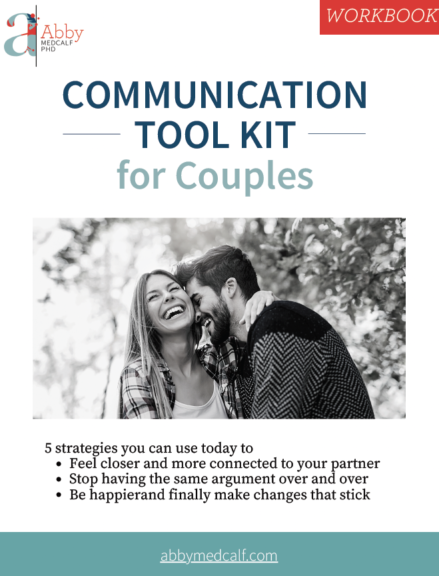
The big reason you get stuck in negativity with your partner is because you’re often trying to fix what’s wrong instead of starting building from what’s right. You don’t build great companies, products, life-changing ideas or great relationships by focusing on what’s wrong. That just sends you down a bad rabbit hole without any of the tools you need to fix what you find.
It’s ALWAYS better to build from strengths than weaknesses. Looking for what’s right in your relationship is also called looking for bright spots. Successful businesses have been using this model for years and I’m going to show you today how you can use it to transform your relationship.
In this blog post I’m going to explain what the heck bright spots are and why you care; The 5 step process to identifying bright spots in your relationship and a super effective tool to help you identify what’s right in your relationship so you can keep the good stuff front and center
To explain bright spots, I’m going to start with a story outlined in Chip and Dan Heath’s book, Switch: How to Change Things When Change is Hard. During the 1980s Vietnam was one of the poorest countries in the world. Poor nutrition among Vietnamese children was a serious public health problem. So in 1990, the government asked the international organization, Save the Children, to come into their country to fight malnutrition.
A man named Jerry Sternin was put in charge but when he arrived he found himself in the middle of some governmental politics and was given very few resources, almost no staff and was told he only had six months to “make a difference” in a large scale, multi-faceted problem.
You see, at the time, it was the popular belief that Vietnam’s malnutrition problem was the result of many larger issues including nation-wide poverty, poor sanitation and a lack of clean water. Solving all these huge problems was going to take a lot longer than six months and was certainly going to require lots of money and tons of staff people. But Jerry had none of those. He was forced to look for a different solution to the malnutrition issue.
Sternin’s strategy was simple but revolutionary. He decided to send his small staff into the different poor towns and look for kids who weren’t malnourished. His solution was to turn the question around. Instead of asking, “Why are children malnourished?” he asked, “What are some mothers doing differently that’s making their children healthier?” He went in search of healthy and even chubby children to find out what made them different or “successful.” He was looking for “bright spots.”
Once his staff started questioning and observing the mothers of healthier children in these poor villages, they found that they were doing some small things differently. For example, the mothers of the healthy children were feeding their kids the same amount of food as the moms whose kids were malnourished, but they were giving it to them in smaller portions which are more digestible for malnourished tummies. They also fed them throughout the day and fed them more actively (making sure they ate all their food). In addition, the “bright spot mothers” were adding things like tiny shrimp and crab as well as sweet potato greens to their children’s food. These added nutrients and protein were also making a difference.
These small behaviors were adding up to huge changes. Six months later, 65% of the children were better nourished and the changes continued after Sternin left. Eventually the program reached over 2.2 million Vietnamese people in 265 villages.
When people come to my office they often feel overwhelmed with their problems. Their issues seem too big to solve or they’ve had the difficulty for so long, they think there’s no way it will ever go away. The secret is that huge problems often only require small, simple steps and a different attitude to create monumental and lasting change.
Next time you approach a problem, instead of asking “What’s broken and how do I fix it?” ask, “What’s working and how can I do more of it?” Think about how you can build on a previous success and go from there. Looking for bright spots is a different and effective way to approach your world. Instead of having a problem focus, think about creating a solution focus.
A great way to do this, is to look for bright spots. Looking for bright spots is a different and effective way to approach your world. Instead of having a problem-focus, think about having a solution-focus.
But how exactly do you do this?
I’m going to give you the five-step process to finding Bright Spots and what works in your relationship.
The Pareto Principle
Before we jump in, I need to start with something called the Pareto Principle. You’ve likely heard of the Pareto Principle; it’s also known as the 80/20 rule. This concept is normally used in business. People in sales and marketing use it to identify their most important customers and products. They know that 20% of their customers give them 80% of their revenue or that 20% of their products give them 80% of the revenue. The most successful companies focus the majority of their attention on the 20%; they know that to excel, this 20% is critical.
By focusing most of their attention on these clients and customers, they’ll make the most money in the least amount of time. They stop focusing on things that don’t add value or they delegate or find support for the things that are necessary, but aren’t in their wheelhouse.
Now, we’re going to apply the Pareto Principle to your relationship.
Imagine if you were to only focus on what you do best, what you rock at – imagine the results you could achieve as well as the way you’d feel. By directing the majority of your energy to your relationship bright spots (which are your relationship’s strengths), you’ll get the results you desire more quickly and with less pain, overall.
Now let’s get to the five-step process for identifying bright spots, so you can start coming from a place of positivity and strength in your relationship.
Step One: Identify What’s Out of Whack
Pick an area of your relationship where you feel out of whack, like things are just totally off balance or steeped in negativity. This is harder than you might think, because I need you to be specific. You start the process by saying things like, “We just don’t communicate” or “She nags me all the time.” These are very broad statements and
I need you to dig a little deeper because staying this “big” won’t be helpful.
For example, if you had a problem at work, you wouldn’t say, “Well, there’s a big money flow issue” and leave it at that. You’d break it down and figure out where and how the specific problems arise with the money flow. You’d problem-solve individual areas and try to find solutions. You need to do the same thing with your relationship issues. I want you to break down these broad areas into smaller chunks.
If the big issue is: “We never communicate” you could break that down into smaller chunks like: “If I disagree with her she thinks I’m criticizing her” or “I have to ask him multiple times to do something and then he gets mad at me for reminding him” or “I tell him about something that’s bothering me and he doesn’t listen, he just goes into fix-it mode” or “She shares her problems with me and then gets upset when I try to help.”
It might feel like there are many ways you don’t communicate, but you’ll be surprised to see themes and the “real issue” if you break it down in this way.
Maybe you always start off the day great, but at the end of the day you find yourselves arguing. So this problem area could be “We argue a lot and have a lot of misunderstandings in the evenings.” Maybe you notice a theme that when folks are worn out or run down there’s more arguing and miscommunication.
Step 2: Identify the Bright Spots
With this in mind, identify a few, key bright spots. Remember the Pareto Principle; this could be just 10 to 20% of your interactions. Think of a time, when the issue wasn’t there, seemed muted or less important.
Don’t cop out on this and think there’s nothing. Do you never communicate, really? Are you sure she’s always nagging you and there’s not one minute that this doesn’t happen? You might have to dig deep and go back a bit in your relationship memory, but it’s there somewhere if you look.
A trick for this is that it’s often easier if you try to recall feeling a certain way with your partner. Remember a specific time you were cracking up, or came together under stress. Think of a time you felt supported or understood. Find that time that you got a compliment, were working effectively together on a project or problem, or had fun and were laughing.
“Never and always” are words to watch. It would be near-impossible for that to be true. The trick is to pick out the times you do communicate effectively, or you do feel appreciated. These are your bright spots.
Step 3: Break it Down
Now we’re going to break down the Bright Spots into specific components we can use. I’m going to use a highly effective tool from the business world that I’ve adapted to the love world.
In the business world we have lots of great tools for what we call “Root Cause Analysis” or RCA. This is usually part of quality management in a company. This is just what it sounds like: trying to break down what seems like a big problem into its underlying causes.
With RCA, you’re identifying 4 specific things:
- What happened
- How it happened
- Why it happened…so that (and here’s the really important part)
- You can identify specific actions to prevent this issue from happening again in the future.
In this case, we’re going to work it back to see what happened, not so that we can prevent it, but so that we can repeat it!
Break it Down with The Five Whys Tool
The Five Whys is a popular tool for root cause analysis that works extremely well in relationships. If you have children, I’ll bet you were immediately turned off with something called The Five Whys. You’re thinking: I don’t want to hear the word “why” any more than I already do. But, stick with me – this one is great and not as annoying as your children, partner or boss.
You can use a blank piece of paper or you can use the free Five Whys Worksheet.
First, identify the Bright Spot you’re using. For example, maybe the bright spot is “We had an awesome week-end together.” Now you’re going to ask the first why for why this situation went so well. You’re going to ask: Why did we have an awesome weekend together?
Then you’re going to write your answer for this first “Why?” Try to be succinct and think of the underlying reason it was so great. Maybe your answer is: We got along really well and didn’t fight once all weekend. This is a fine answer, but we’re not at a root cause because it’s not something you can replicate because you don’t yet know why you got along so well and didn’t fight.
So, now you’re going to ask your second “Why?” and you’re going to ask: Why didn’t we fight? The answer to that new question might be “Because I was in a good mood because my partner wasn’t nagging me.” We’re still not there, so we’re going to ask our third “Why”.
This question would be something like: “Why wasn’t my partner nagging me?” The answer for Why #3 could be “Because I did all the jobs s/he asked before the weekend started.” We’re still not at a root cause, so we’re going to ask “Why?” a fourth time.
The next question might be: “Why did I do all the jobs before the weekend started?” The answer might be: Because I made them a priority during the week and caught up on all the stuff I’d been ignoring.
Now we’re going to go to “Why?” number 5 and ask: “Why did I finally make my to-do list a priority?” The answer to this “Why” might be: Because I made it a priority to leave work on time so I had more time and energy when I got home. Now we’re on to something. Now we’re onto a root cause and something we want to work with.
An important note about this exercise. You have to stop when you’ve taken it to something you can’t control. For example, in this case, you might have thought the original root cause was because your partner was more patient than usual – this is not something you can control. So, you need to look back and see what you can control in your answer. For example, you can control your responses when your partner is impatient.
Now that you have at least one root cause, you’re ready to identify strengths, clarity and action steps. And this is all on your handout. The strengths in this situation might be: I’m patient, fun and kind when I give myself room to breath; Boundaries help my life; I get a lot done with my time; I’m capable.
Next you’re going to write down any clarity you’re having after completing this exercise. In this situation it might be: when I can leave work on time, I need to. I need to work on prioritizing my workday more and remember that it affects not only my home life but my mood and thoughts as well. These are sort of like any “aha’s” you might have had from doing this.
Lastly, identify action steps: These should be specific and the steps should be small and sequential. In this case you might write down: I need to focus on sticking to my schedule during the day or I need to remember to say “no” when I really don’t need to be involved.
One last note. You can stop before five “whys?” or it might take you more than five. You just need to go with it. Remember sometimes there’s more than one root cause. Now let’s get back to our five-step process for finding Bright Spots.
Step 4: Emphasize the Bright Spot
The next step is to find ways to emphasize a Bright Spot or Bright Spot component. Think back to what you learned from The Five Whys Worksheet.
What did the root cause analysis tell you? That you need to take days off from work more often? That you do better when you work out early? That you need to focus on self-awareness and meditate more? Whatever it told you, do these things more. Each day think how you could incorporate a bright spot component or action step from your Five Whys into your day.
Step 5: Eliminate the Dark Spots
Step Five is the flip side of Step Four. In step four you were focused on adding things. In step five, you’re focused on eliminating things that don’t work or what we can refer to ask Dark Spots.
You now want to find ways to downplay, problem-solve or eliminate common negative situations so that these bright spot practices have more focus and can be used more readily.
For example, I was recently seeing a couple that fought all the time about whose turn it was to walk the dog in the morning. It would be the husband’s turn, but he had an early meeting, then he was supposed to make up the day, but he’d argue that he already made it up. They started to create spreadsheets and calendar reminders and all forms of craziness around walking the damn dog in the morning and they were having epic battles and starting almost every workday off on a negative note. The big solution?
Get a neighborhood kid to come in the morning and walk the dog. At first they argued that this was an unnecessary way to spend money, they just needed to figure this out, blah, blah, blah. Sometimes you need to get over what’s “reasonable” and just get the damn issue off your plate. You can talk all day long about how something “should” be, but if you can just get past that and accept what “is” as opposed to what “should be,” you might find some peace.
Positive psychology research tell us clearly that if we focus on developing and using more of our strengths it’ll help us to get the best from ourselves and feel happier.
I’m not saying you can completely ignore your weaker areas.
You still need to manage those, especially the ones that trip you up the most or that are holding you back. But, don’t try to be great at these. When it comes to limitations, shoot for good enough or get them off your plate.






